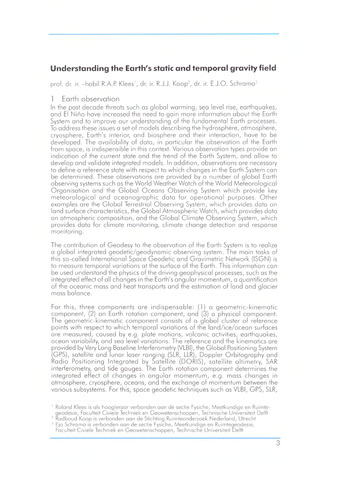Understanding the Earth's static and temporal gravity field
3
prof. dr. ir. -habil R.A.R Klees1, dr. ir. R.J.J. Koop2, dr. ir. E.J.O. Schrama3
1 Earth observation
In the past decade threats such as global warming, sea level rise, earthquakes,
and El Nino have increased the need to gain more information about the Earth
System and to improve our understanding of the fundamental Earth processes.
To address these issues a set of models describing the hydrosphere, atmosphere,
cryosphere, Earth's interior, and biosphere and their interaction, have to be
developed. The availability of data, in particular the observation of the Earth
from space, is indispensible in this context. Various observation types provide an
indication of the current state and the trend of the Earth System, and allow to
develop and validate integrated models. In addition, observations are necessary
to define a reference state with respect to which changes in the Earth System can
be determined. These observations are provided by a number of global Earth
observing systems such as the World Weather Watch of the World Meteorological
Organisation and the Global Oceans Observing System which provide key
meteorological and oceanographic data for operational purposes. Other
examples are the Global Terrestrial Observing System, which provides data on
land surface characteristics, the Global Atmospheric Watch, which provides data
on atmospheric composition, and the Global Climate Observing System, which
provides data for climate monitoring, climate change detection and response
monitoring.
The contribution of Geodesy to the observation of the Earth System is to realize
a global integrated geodetic/geodynamic observing system. The main tasks of
this so-called International Space Geodetic and Gravimetric Network (ISGN) is
to measure temporal variations at the surface of the Earth. This information can
be used understand the physics of the driving geophysical processes, such as the
integrated effect of all changes in the Earth's angular momentum, a quantification
of the oceanic mass and heat transports and the estimation of land and glacier
mass balance.
For this, three components are indispensable: (1) a geometric-kinematic
component, (2) an Earth rotation component, and (3) a physical component.
The geometric-kinematic component consists of a global cluster of reference
points with respect to which temporal variations of the land/ice/ocean surfaces
are measured, caused by e.g. plate motions, volcanic activities, earthquakes,
ocean variability, and sea level variations. The reference and the kinematics are
provided by Very Long Baseline Interferometry (VLBI), the Global Positioning System
(GPS), satellite and lunar laser ranging (SLR, LLR), Doppler Orbitography and
Radio Positioning Integrated by Satellite (DORIS), satellite altimetry, SAR
interferometry, and tide gauges. The Earth rotation component determines the
integrated effect of changes in angular momentum, e.g. mass changes in
atmosphere, cryosphere, oceans, and the exchange of momentum between the
various subsystems. For this, space geodetic techniques such as VLBI, GPS, SLR,
1 Roland Klees is als hoogleraar verbonden aan de sectie Fysiche, Meetkundige en Ruimte-
geodesie, Faculteit Civiele Techniek en Geowetenschappen, Technische Universiteit Delft
2 Radboud Koop is verbonden aan de Stichting Ruimteonderzoek Nederland, Utrecht
3 Ejo Schrama is verbonden aan de sectie Fysiche, Meetkundige en Ruimtegeodesie,
Faculteit Civiele Techniek en Geowetenschappen, Technische Universiteit Delft

